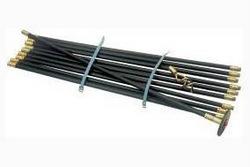How to unblock a drain. Tips and tricks for the self sufficient.
Posted by Fiona Nevile in Reviews, Save Money | 23 commentsWhen I stepped out of the car this morning I noticed a large puddle in the drive.
“It must have rained hard when I was out.” I thought.
Then I noticed the seepage from the drain cover and that pervasive smell. Sewage.
This is not a leave until later job. Raw sewage seeping down the drive is a health hazard. Most city dwellers have to call in a Drain Cleaning Company – with an impressive van and expensive jet cleaning equipment. Even though they are wearing overalls they don’t really need to get their hands dirty. Just lever off the drain cover, shove the turbo charged rod in deep and switch on.
Country bumpkins like me tend to have our own drain rods and if I did move back to a city I’d definitely take them with me. I’ve had mine since I moved in 20 years ago. The drain blocking culprit is our beautiful willow tree. It stands ten feet away from the drain and like a determined dictator, its tiny black roots search far and wide to maintain the lofty tree. These tiny roots can break through drainpipes and concrete.
We had the drains rebuilt a few years ago but that little black roots of pesky willow have silently, steadily infiltrated the drain again. The tree has to go which is a shame as I love it.
There are four rules for successfully unblocking a drain. Never, ever think about what the effluent actually is. Always wear sturdy rubber gloves that can be washed after the deed is done – you will be handling rods that have ventured deep into the blockage. Stand well back – it can be a bit splashy when the drain gurgles with relief and starts to empty. And, most important of all, remember to always turn the rods the same way so they don’t unscrew in the drain. The Penultimate Paramour lost some rods in our drain once but managed to retrieve them as I squawked with horror from the kitchen – I never discovered how he managed to achieve this feat. Was it luck or skill?
Today’s job took an hour and a half. The drains were blocked from the road right back to the cottage in two directions – approximately 120’. The sort of backup that would have a professional drain busting team rubbing their hands with joy at the thought of the fee. I remember back in the 1980’s in London, a friend paid £400 for her drains to be cleared. That’s why I originally invested in my rods. They were £14.99 at the time and seemed a bargain. It’s worth investing in a set with good brass fittings and attachments – they should last a lifetime.
The rubber plunger is best for clearing the matted willow roots, despite their persistence in finding moisture they are quite delicate when faced with a sturdy disk, wielded with a determined hand.
You need to work out the distance from your drain cover to the main drain on the road outside. Each of our rods is a yard long so it’s easy to work out how far the line of rods has penetrated. Moving the rods back and forth eventually will dislodge any blockage and with a wonderful gluggy and messy gurgle everything eventually sloshes steadily away. This can take some time and you need to babysit the drain as you might need to plunge again.
Finally when everything looks clear enough to impress the pickiest of surveyors you have succeeded! Then all there’s left to do is the satisfactory slow washing the drain, cover and rods with a hose. Throw your gloves into the washing machine. Pop on the kettle for a well earned cup of tea after sterilising the rods with boiling water. The last step is the best – the triumphal return to the cottage and chest banging announcement.
“I’ve cleared the drains.”
Clearing drains is messy, yes. But it earns you a zillion Brownie points that can be cashed in for months. Danny is busy cleaning the bathroom as my fingers fly across the keyboard.
Even if you don’t have a hungry willow tree drain rods are reasonably inexpensive and a great investment. We have used them to unblock the main drain too, when nappies from the long gone next door neighbour’s baby caused a problem. The rods also double as chimney sweeping rods – the chimney brush heads available at your local builder’s merchant should fit your rods.
Although I sometimes curse them when I fall over them in the barn, I wouldn’t be without my drain rods. They have saved me loads of money over the years.
Leave a reply







I liked that you explained that you should try to survey the drain before clearing the blockage. It might be smart for me to get my sewer drains inspected. That way, I know what type of condition it is in.
Thanks for your glog blog, sturdy advice managed to un-gurgle the glug.
Great article.Its really beneficial & Informative post.Thank you for sharing your knowledge with us.
Visit for plumbing services http://perth-plumber.com/
This is some great information, and I appreciate your advice to always rotate the rods the same direction. My sewer pipes have drainage issues, so we have to clear the pipes annually, usually. In the past, my husband and I have typically just rented a snake, but after reading this, I think we’ll consider investing in some drain rods. We’ll definitely make sure to always turn them the same direction, when we do! http://www.andrewvannyplumbing.com.au/blocked-drain-clearing/
Love the rule ‘Never, ever think about what the effluent actually is’
The other thing to watch is you have to only twist the rods clockwise else they will unscrew. This means if you use one of the “corkscrew” ends on the rod (designed to screw into a tough blockage and then pull it back) be sure you are not going to get it around a root that has made its way into the drain as you won’t be able to unscrew the corkscrew from the root and you will need the strength to pull it all back. I always start with one of those 4″ rubber discs on the end that act as a wonderful plunger in our drains.
Anything can cause a blocked pipe – from tiny particles of food to huge pieces of vegetable peel. Blocked drainage is a common problem which is kitchen’s worst enemy. As a prevention performing a periodical flush of the kitchen drain pipe by putting on the stopper and removing it makes the water in the sink will flow down the pipe and the force generated by its weight should be enough to clean the pipe of any small debris.
Using of drain rods will also be used to help dislodge and alleviate clogged pipes and drains.
Hi Fiona, great to hear you have found a method that works well. My only advice to people experiencing their first blocked drain is to not be too aggressive with any implement you put into the pipe.
Thanks,
Tom
I work for a drainage company myself and would encourage people to give it a go themselves first. A lot of the time it is only a little job but if you find your drainage rods don’t work, then you should call someone.
S.J.
Really helpful post thank you! Keep up the great work.
Oh how glad am i that i read your blog. Drain was blocked this morning so I thought what can i lose, nipped to b and q bought a pink (GOODNESS ONLY KNOWS WHO THOUGHT – YES PINK THATS THE CHAP) set of drain rods, and bingo cleared my stinky drain myself. Grand cost of £27.99 dread to think how much mr dyno rod would have cost. So thank you for your blog you saved me a fortune – and everyone its incredibly easy albeit stinky.